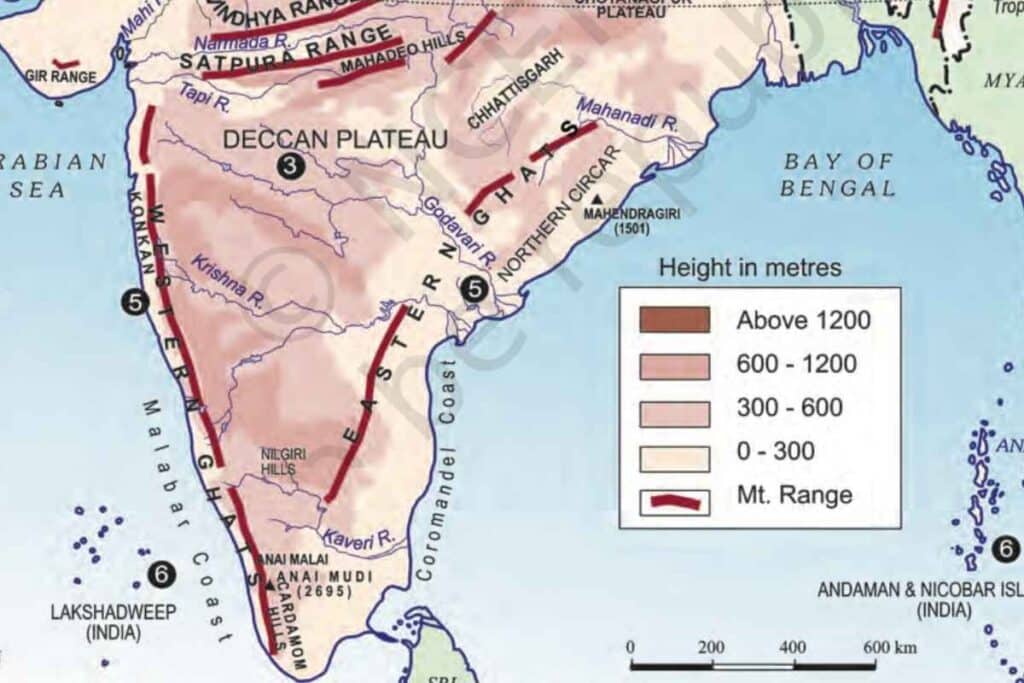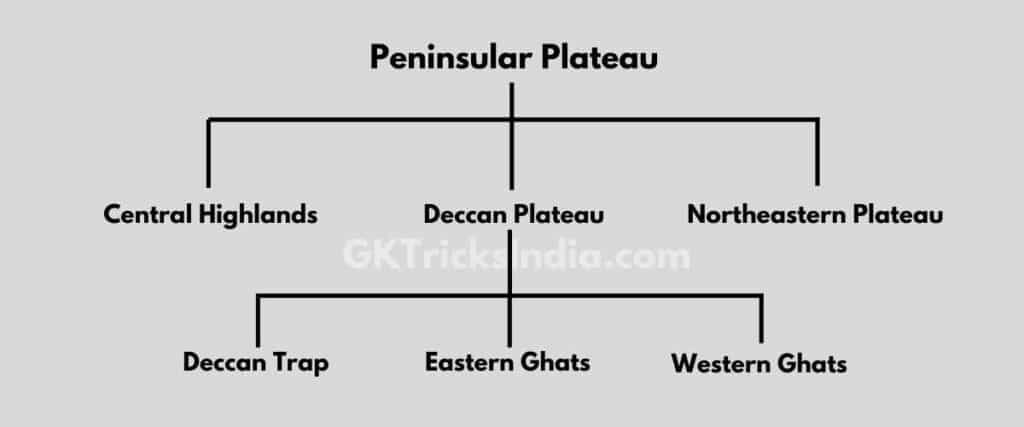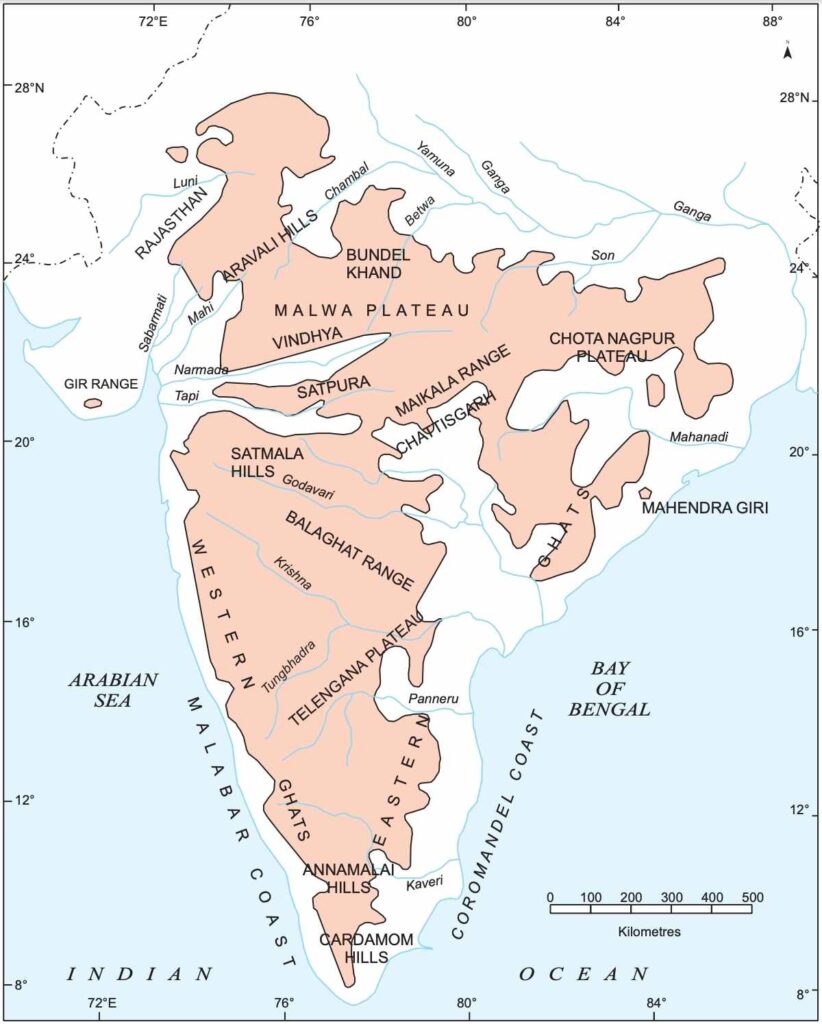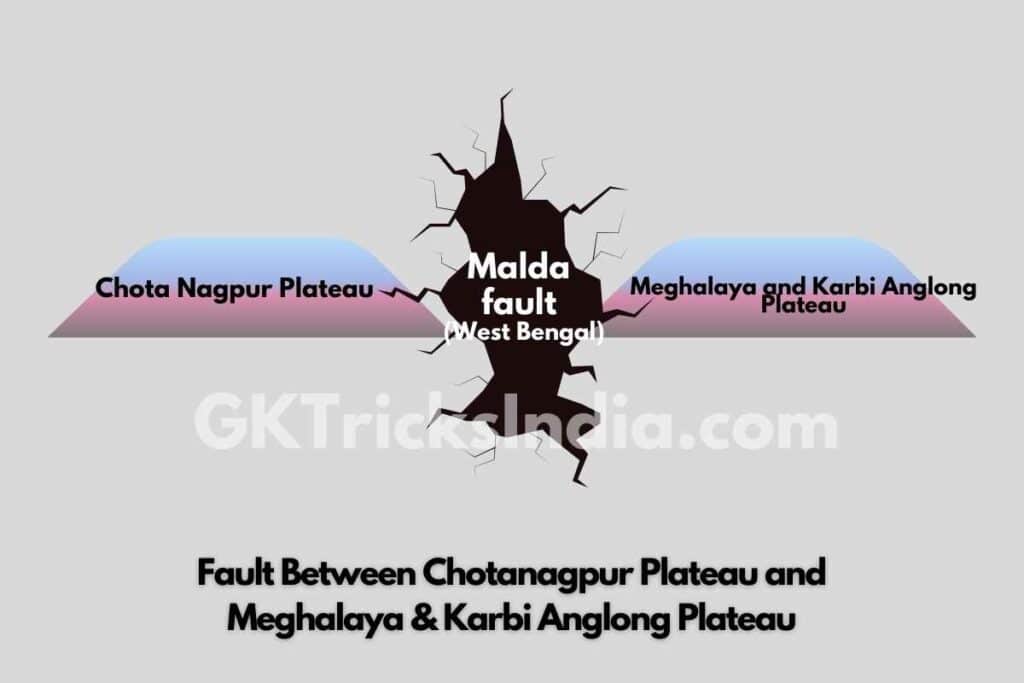Point by point, map, and chart explanations of Peninsular Plateau in India. Important study material that can be asked in various competitive exams.

Peninsular Plateau Meaning
A tableland made up of ancient crystalline, igneous, and metamorphic rocks is known as the Peninsular plateau. It belongs to the oldest continent since it was created by the fracturing and drifting of the Gondwana region. The plateau contains rounded hills and wide, shallow valleys.
The Peninsular Plateau is also known as the Plateau of Peninsular India

Important facts about Peninsular Plateau
- The triangular region spread to the south of the Ganges Indus plain is called Peninsular Plateau or Peninsular India.
- Its average altitude is 600 to 900 meters.
- Its slope is from west to east.
- Its area is 16 lakh square kilometers.
- It is surrounded by sea on all three sides. The Eastern Ghats and the Western Ghats are the eastern and western boundaries of this region respectively, which separate the plateau region from the coastal plains.
- It is table-shaped.
- The peninsular plateau is formed of older crystalline igneous and metamorphic rocks are the reason why it is a part of the oldest landmass.
According to the main relief features, the Peninsular Plateau has three parts:
- Central Highlands
- The Deccan Plateau
- The Northeastern Plateau

Central Highlands
- The central highlands, that part of the peninsular plateau to the north of the Narmada, covers most of the Malwa plateau.
- Here the Vindhya range is bounded by the Satpuras in the south and the Aravallis in the northwest. These are excellent examples of residual mountains that are largely eroded and have broken chains.
- Main rivers of this region: Chambal, Betwa, Ken (from South-West to North-East)
- The eastern extensions of this plateau are Bundelkhand and Baghelkhand.
- The region has undergone metamorphic processes throughout its geological history and is evidenced by the presence of metamorphic rocks such as the Marble Plate and Nice.
- The Banas, the only major tributary of the Chambal, originates from the Aravalli in the west.
- The eastern extension of the central highlands extends to the Rajmahal hills. The Chota Nagpur Plateau, located to its south, is a storehouse of minerals.
- In the Bhima fault, there is frequent seismic movement here.
- In the northwest part of this plateau, there are river blocks and mahakhands which complicate its surface. Like Chambal Bhind Morena Khand.
Deccan Plateau
- Deccan Plateau Location: Triangular terrain which is situated on the banks of Narmada
- Located in the north is the Satpura range on the broad base while the hills of Mahadev Kaimur and the Maikal range are its eastern extension.
- The southern part of the Peninsular Plateau is divided into three parts:
- Deccan Trap
- The Eastern Ghats and
- Western Ghats
What separates Central highlands Deccan Plateau?
Narmada rivers divide the ‘Deccan Tableland’ from Central Highland in northern India. Narmada river and Vindhyan range divides the Deccan Plateau into two parts. Upper part is known as central highlands and lower part is known as Deccan plateau.
Deccan Trap
- The Deccan Trap is considered to be the nucleus.
- The oldest rocks of India are found here.
- It is made of fibrous rocks.
- Lava deposits are found on its surface.
Eastern Ghats
- Its height is comparatively less.
- It extends from Mahanadi to Nilgiris.
- It is not continuous.
- The highest peak of this is Mahendra Giri.
- It is eroded by Mahanadi Godavari, Krishna, and Kaveri.
Western Ghats
- It is not continuous and can be crossed only through passes. The main passes are: Thal Ghat, Bhor Ghat, Palghat
- Here there is mountain rainfall, that is, the rain is due to the collision of moist air on the western slope of the Ghat and rises up.
- The Western Ghats are locally known by various names:
- Sahyadris in Maharashtra
- Nilgiris in Karnataka and Tamil Nadu
- Annamalai and Kardamam in Kerala

- Most of the peninsular rivers have their origin in the Western Ghats.
- Its average height is 15 meters.
- The highest peak of the Peninsular Plateau is Anaimudi which is situated on the Annamalai Hills of the Western Ghats.
- The soil here is black, which is called the Deccan Trap. It originated from igneous rock.
- The Eastern and Western Ghats meet each other in the Nilgiri Hills.
This Central Highlands and Deccan Plateau are the main parts of the peninsular plateau.
The Northeastern Plateau
- In fact, it is an extended part of the peninsular plateau itself.
- On the basis of the names of the tribes living here, the Meghalaya plateau is divided into three parts:
- Garo
- Khasi and
- Jaintia Hills
- The Karbi Anglong Hills of Assam are also an extension of this.
- Like the Chota Nagpur plateau, the Meghalaya plateau also has deposits of minerals such as coal, iron, sillimanite, limestone, and uranium.
- The Meghalaya Plateau is a highly eroded site.
- Cherrapunji is a place covered with naked rocks and there is little vegetation here.

Read also: Mountainous Region of India
Read also: Great Plains of India | Great Plains of North India
What is Peninsular plateau?
The Peninsular plateau is a tableland composed of old crystalline, igneous and metamorphic rocks. It was formed due to the breaking and drifting of the Gondwana land and thus, making it a part of the oldest landmass. The plateau has broad and shallow valleys and rounded hills.
Where is Peninsular Plateau located?
The part of the Peninsular plateau lying to the north of the Narmada river covering a major area of the Malwa plateau is known as the Central Highlands. The Deccan Plateau is a triangular landmass that lies to the south of the river Narmada.
Why plateau is called peninsular?
A Peninsula is any landmass that is surrounded by water on three sides and land on one side. India is called Peninsula because it is surrounded by the Indian Ocean on the south, the Arabian Sea on the west, and the Bay of Bengal on the east.
How many peninsular plateaus are there?
There are 7 major Plateaus of Peninsular India:
The Marwar Plateau, Central Highland, Bundelkhand Upland, Malwa Plateau, Baghelkhand, Chota Nagpur Plateau, Meghalaya Plateau, Deccan Plateau and Chhattisgarh Plain.
Which is the Peninsular Plateau region of India?
The triangular region spread to the south of the Ganges Indus plain is called Peninsular Plateau or Peninsular India.
What is famous in Peninsular Plateau?
Biodiversity. The Deccan Plateau is famous for its biodiversity. The area is home to an exotic range of flora and fauna. Two of India’s most significant elephant conservation regions, the Anamalais-Nelliampathis and the Nilgiris-Eastern Ghats are located in this area.
Which is the largest Peninsular Plateau in India?
Deccan Plateau is the largest plateau in India. The Deccan Plateau is a triangular landmass that lies to the south of the river Narmada. The Satpura range flanks its broad base in the north while the Mahadev, the Kaimur hills, and the Maikal range form its eastern extensions.
Which plateau is known as Central highlands?
Indian Peninsular plateau is divided into two major halves i.e. Central Highlands and Deccan Plateau. The part of the Peninsular plateau lying towards the north of the Narmada river which covers the major areas of the Malwa Plateau is known as the Central Highlands.
Friends, if you find any kind of mistake or error in this article then please comment or mail us, so that we can rectify these mistakes.

